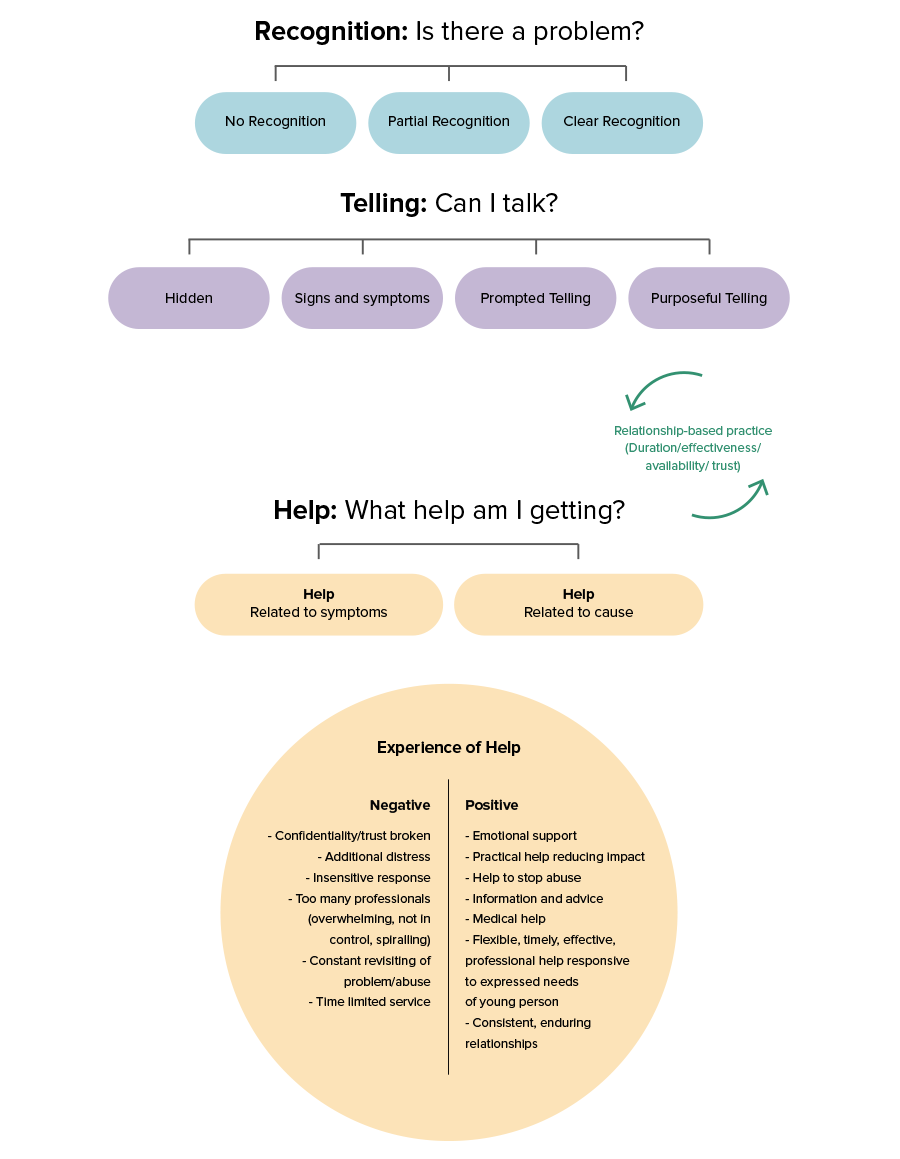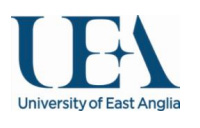‘It takes a lot to build trust’. Recognition and Telling: Developing earlier routes to help for children and young people.
The findings from the study were used to generate a conceptual framework for understanding recognition, telling and help from the point of view of the child.

Framework for understanding recognition, telling and help

The framework contains three distinct components which can make sense of children’s and young people’s experiences. Importantly it is non-linear so that a child’s progress is not solely from the top level (recognition) towards the bottom (receiving help). Individual young people experiencing problems of abuse and neglect can follow different pathways. Crucially recognition often occurs as a result of conversations with others. Thus clear recognition does not always happen before telling or receiving help, but can sometimes be a result of help received. One logical pathway would be that a young person recognizes the abusive situation, purposefully tells someone about it and then receives help. However, in the interview study this was a rare occurrence. In fact most of the young people in the interview study followed a pathway beginning either with not recognizing or partially recognizing their situation and first came to the attention of services though the ‘signs and symptoms’ route for telling.
Their pathways were complex and positive and negative feedback loops were possible. A young person who tried to tell might receive help relating to the abuse, or they could conceivably find that their case was closed and no service was offered.
They might get help with the presenting problem that did not get to the heart of the underlying abusive situation.
Recognition
At the first level is recognition. This relates to whether or not a young person realises that the situation is abusive. A young person may move along the spectrum from not recognizing to recognizing that the situation is problematic. Recognition was often described as a process which developed as a child grew older and was able to take a broader perspective and increasingly able to make comparisons between their own situation and those of others. Partial recognition sometimes involved an emotional awareness that things were not right, before a child was able to articulate it to themselves or to others. Crucially recognition often occurs as a result of dialogue with others. Thus clear recognition is not an essential precursor to telling or receiving help, but can sometimes be a result of help received.
Telling
The second level is telling and involves a continuum of four different possibilities, remaining hidden, exhibiting signs and symptoms, prompted telling and purposeful telling. The first two of these possibilities involve the young person not speaking out verbally about abuse. Being hidden may involve actively avoiding telling (hiding a situation from others or denying there is anything wrong) or passively not telling because the young person does not recognize there is a problem, or because no one asks. Hence it is possible to be on the spectrum of telling whether or not the young person recognizes there is a problem.
Help
The initial response to telling can result in a number of types of help. For example a young person who comes to the attention of services because of criminal damage might receive anger management relating to that presenting symptom. Alternatively there might be a more holistic response which picks up on underlying issues relating to the underlying cause, the abusive situation. A young person who has tried to tell may receive help relating to the abuse, or they could conceivably find that their case is closed and no service is offered. There were positive experiences of help where young people experienced emotional support, information and advice, help stopping the abuse and/or strategies to minimize harm.
Cultural norms
Cultural norms could deter children from disclosing abuse, and address notions of shame, taboo, modesty, honour and respect. Fontes (2010) discussed these concepts in relation to child sexual abuse across a number of cultural settings. Interviews in Italy with adolescent child abuse victims revealed shame, and a fear of causing trouble to the family, to be strong barriers to telling (Crisma et al, 2004). ‘Family shame’ and ‘courtesy and face’ were important concepts in a study of Hong Kong Chinese children suffering from abuse and neglect (Chan, 2011). African American young people and Hispanic girls have been found to be less likely to disclose sexual abuse than their white American peers (Hanson et al, 2003, London et al, 2005). The under reporting of child sexual abuse in Britain’s Asian communities was compounded by notions of honour/respect (izzat), modesty (haya), and shame or embarrassment (sharam), (Gilligan et al, 2006).
The authors concluded, however, that practice based on generalized assumptions about ethnicities, cultures or religions, was to be avoided. There was some evidence that children, and particularly black children, disclosed secrets more readily to an interviewer of the same race (Dunkerley, 2000).
A study in detail
___
EU Safeguarding policy guidance
EU policy guidance for the safeguarding for children and young people emphasize the need for
better protection for children and young people from abuse and harm, especially among vulnerable groups I.e.
children and young people with disabilities or those seeking asylum. All EU member states are signed up to the
United Nations Convention on the Rights of The Child, which serves as one pillar to the EU’s position on child
protection. The policy guidance documents (See EU Guidelines for the Promotion and Protection of the Rights
of the Child 2007, An EU Agenda for the Rights of the Child 2011,
Citizens’ rights and constitutional affairs 2012, EU acquis and policy documents on the rights of the child
2015, and Coordination and cooperation in integrated child protection systems 2015) seek to provide
protection to all children and young people to promote their human rights so that they are aware and know
where to receive help without fear. The EU safeguarding policies also place emphasis on governments at the
national level to do more to protect children and young people and uphold their rights by continually
improving services available to them.
References
European Commission (2007) EU Guidelines for the Promotion and Protection of the Rights of the Child. Brussels
European Commission (2011) An EU Agenda for the Rights of the Child. Brussels.
European Parliament (2012) Citizens’ rights and constitutional affairs. Brussels
European Commission (2015) EU acquis and policy documents on the rights of the child. Brussels.
European Commission (2015) Coordination and cooperation in integrated child protection systems. Brussels
From the game stories
Physical Abuse
Topic covered: bullying, neglect, violence
A form of abuse which may involve hitting, shaking, throwing, poisoning, burning or scalding, drowning, suffocating or otherwise causing physical harm to a child. Physical harm may also be caused when a parent or carer fabricates the symptoms of, or deliberately induces, illness in a child.
more…
Emotional abuse Topic covered: Grooming
The persistent emotional maltreatment of a child such as to cause severe and persistent adverse effects on the child’s emotional development. It may involve conveying to a child that they are worthless or unloved, inadequate, or valued only insofar as they meet the needs of another person. It may include not giving the child opportunities to express their views, deliberately silencing them or ‘making fun’ of what they say or how they communicate. It may feature age or developmentally inappropriate expectations being imposed on children. These may include interactions that are beyond a child’s developmental capability, as well as overprotection and limitation of exploration and learning, or preventing the child participating in normal social interaction. It may involve seeing or hearing the ill-treatment of another. It may involve serious bullying (including cyberbullying), causing children frequently to feel frightened or in danger, or the exploitation or corruption of children. Some level of emotional abuse is involved in all types of maltreatment of a child, thought it may occur alone
more…
Sexual abuse Topic covered: a wide range of topics, Emotional/Physical
Involves forcing or enticing a child or young person to take part in sexual activities, not necessarily involving a high level of violence, whether or not the child is aware of what is happening. The activities may involve physical contact, including assault by penetration (for example, rape or oral sex) or non-penetrative acts such as masturbation, kissing, rubbing and touching outside of clothing. They may also include non-contact activities such as involving children in looking at, or in the production of, sexual images, watching sexual activities, encouraging children to behave in sexually inappropriate ways, or grooming a child in preparation for abuse (including via the internet). Sexual abuse is not solely perpetrated by adult males. Women can also commit acts of sexual abuse, as can other children.
more…
Neglect Topic covers a wide range of topics, Emotional/Physical
The persistent failure to meet a child’s basic physical and/or psychological needs, likely to result in the serious impairment of the child’s health or development. Neglect may occur during pregnancy as a result of maternal substance misuse. Once a child is born, neglect may involve a parent or carer failing to:
- Provide adequate food, clothing and shelter (including exclusion from home or abandonment)
- Protect a child from physical and emotional harm or danger
- Ensure adequate supervision (including the use of inadequate caregivers); or ensure access to appropriate medical care or treatment.
It may also include neglect of, or unresponsiveness to, a child’s basic emotional needs.
more…
___


